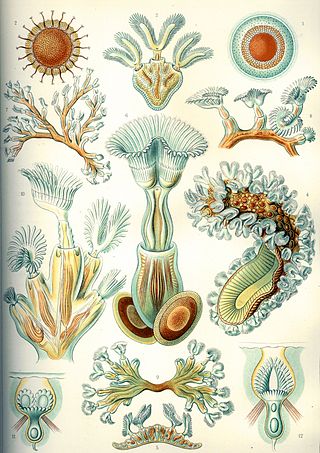
Bryozoa are a phylum of simple, aquatic invertebrate animals, nearly all living in sedentary colonies. Typically about 0.5 millimetres long, they have a special feeding structure called a lophophore, a "crown" of tentacles used for filter feeding. Most marine bryozoans live in tropical waters, but a few are found in oceanic trenches and polar waters. The bryozoans are classified as the marine bryozoans (Stenolaemata), freshwater bryozoans (Phylactolaemata), and mostly-marine bryozoans (Gymnolaemata), a few members of which prefer brackish water. 5,869 living species are known. Originally all of the crown group Bryozoa were colonial, but as an adaptation to a mesopsammal life or to deep-sea habitats, secondarily solitary forms have since evolved. Solitary species has been described in four genera; Aethozooides, Aethozoon, Franzenella and Monobryozoon). The latter having a statocyst-like organ with a supposed excretory function.
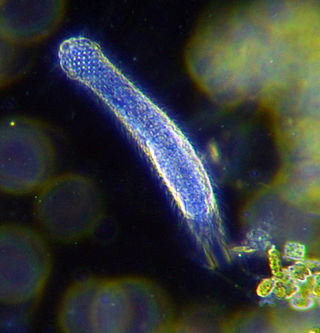
The gastrotrichs, commonly referred to as hairybellies or hairybacks, are a group of microscopic (0.06–3.0 mm), cylindrical, acoelomate animals, and are widely distributed and abundant in freshwater and marine environments. They are mostly benthic and live within the periphyton, the layer of tiny organisms and detritus that is found on the seabed and the beds of other water bodies. The majority live on and between particles of sediment or on other submerged surfaces, but a few species are terrestrial and live on land in the film of water surrounding grains of soil. Gastrotrichs are divided into two orders, the Macrodasyida which are marine, and the Chaetonotida, some of which are marine and some freshwater. Nearly 800 species of gastrotrich have been described.

Nepenthes is a genus of carnivorous plants, also known as tropical pitcher plants, or monkey cups, in the monotypic family Nepenthaceae. The genus includes about 170 species, and numerous natural and many cultivated hybrids. They are mostly liana-forming plants of the Old World tropics, ranging from South China, Indonesia, Malaysia, and the Philippines; westward to Madagascar and the Seychelles (one); southward to Australia (four) and New Caledonia (one); and northward to India (one) and Sri Lanka (one). The greatest diversity occurs on Borneo, Sumatra, and the Philippines, with many endemic species. Many are plants of hot, humid, lowland areas, but the majority are tropical montane plants, receiving warm days but cool to cold, humid nights year round. A few are considered tropical alpine, with cool days and nights near freezing. The name "monkey cups" refers to the fact that monkeys were once thought to drink rainwater from the pitchers.

Hydrozoa is a taxonomic class of individually very small, predatory animals, some solitary and some colonial, most of which inhabit saline water. The colonies of the colonial species can be large, and in some cases the specialized individual animals cannot survive outside the colony. A few genera within this class live in freshwater habitats. Hydrozoans are related to jellyfish and corals and belong to the phylum Cnidaria.

A tunicate is an exclusively marine invertebrate animal, a member of the subphylum Tunicata. This grouping is part of the Chordata, a phylum which includes all animals with dorsal nerve cords and notochords. The subphylum was at one time called Urochordata, and the term urochordates is still sometimes used for these animals. They are the only chordates that have lost their myomeric segmentation, with the possible exception of the seriation of the gill slits. However, doliolids still display segmentation of the muscle bands.

Proteus is a genus of Gram-negative bacteria. It is a rod shaped, aerobic and motile bacteria, which is able to migrate across surfaces due its “swarming” characteristic in temperatures between 20 and 37 °C. Their size generally ranges from 0.4 to 0.8 μm in diameter and 1.0–3.0 μm in length. They tend to have an ammonia smell. Proteus bacilli are widely distributed in nature as saprophytes, being found in decomposing animal matter, sewage, manure soil, the mammalian intestine, and human and animal feces. They are opportunistic pathogens, commonly responsible for urinary and septic infections, often nosocomial.

Thaliacea is a class of marine chordates within the subphylum Tunicata, comprising the salps, pyrosomes and doliolids. Unlike their benthic relatives the ascidians, from which they are believed to have emerged, thaliaceans are free-floating (pelagic) for their entire lifespan. The group includes species with complex life cycles, with both solitary and colonial forms.
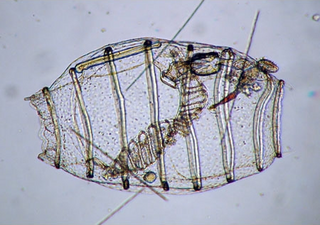
The Doliolida are an order of small marine chordates of the subphylum Tunicata. They are in the class Thaliacea, which also includes the salps and pyrosomes. The doliolid body is small, typically 1–2 mm long, and barrel-shaped; it features two wide siphons, one at the front and the other at the back end, and eight or nine circular muscle strands reminiscent of barrel bands.

Proteus mirabilis is a Gram-negative, facultatively anaerobic, rod-shaped bacterium. It shows swarming motility and urease activity. P. mirabilis causes 90% of all Proteus infections in humans. It is widely distributed in soil and water. Proteus mirabilis can migrate across the surface of solid media or devices using a type of cooperative group motility called swarming. Proteus mirabilis is most frequently associated with infections of the urinary tract, especially in complicated or catheter-associated urinary tract infections.

A salp or salpa is a barrel-shaped, planktonic tunicate in the family Salpidae. It moves by contracting, thereby pumping water through its gelatinous body; it is one of the most efficient examples of jet propulsion in the animal kingdom. The salp strains the pumped water through its internal feeding filters, feeding on phytoplankton.

Nepenthes mirabilis, or the common swamp pitcher-plant and tropical pitcher plant, is a carnivorous plant species. By far the most widespread of all Nepenthes, its range covers continental Southeast Asia and all major islands of the Malay Archipelago, stretching from China in the north to Australia in the south. The species exhibits great variability throughout its range. One of the more notable varieties, N. mirabilis var. echinostoma, is endemic to Borneo and possesses an extremely wide peristome.
Dolioletta is a genus of tunicates in the family Doliolidae.

Doliolidae is a family of tunicates in the order Doliolida. Members of the family are pelagic and often found far away from coastlines.
Dolioletta gegenbauri is a species of tunicate in the family Doliolidae. It is small, exists in various forms and is sometimes found in great abundance in the Atlantic and Pacific waters where it lives.

Haworthia mirabilis is a species of the genus Haworthia belonging to the family Asphodelaceae.

Acraea mirabilis, the marvelous acraea, is a butterfly in the family Nymphalidae. It is found in Somalia, south-eastern Ethiopia and north-eastern Kenya.

Hydroids are a life stage for most animals of the class Hydrozoa, small predators related to jellyfish.
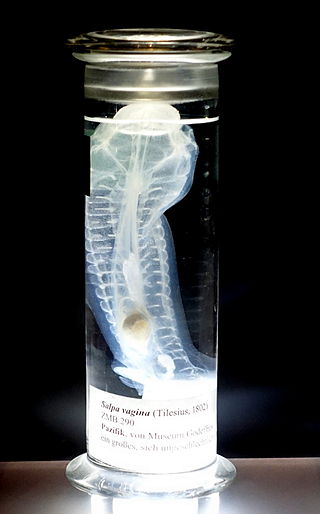
Thetys vagina, or the twin-sailed salp, is the largest known solitary species of salp and the only valid species of the genus Thetys. First described by W.G Tilesius in 1802, the species is transparent and gelatinous, making it difficult to be seen in water, which is helpful in avoiding predators. The fossil range is very recent. Other animals often mistaken for T. vagina are Salpa fusiformis, Aurelia aurita, and Pegea confoederata. There is no known status of conservation in this species. T. vagina DNA was sequenced as part of a larger project in 2014 where spiny lobster larvae were found attached to T. vagina and consuming it.
A gonozooid is any of the reproductive individuals of tunicate, bryozoan, or hydrozoan colonies that produce gametes. Gonozooids may play a role in labour division or in alternation of generations. A gonozooid typically has hardly any other function than reproduction, amounting to little more than a motile gonad.
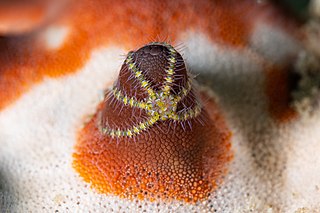
Ophiothela mirabilis is a species of ophiuroid brittle star within the family Ophiotrichidae. O. mirabilis is an epizoic species which have a non-parasitic relationship with host sponges or gorgonians. Although native to the Pacific Ocean, it has invaded the Caribbean and southwestern Atlantic since late 2000. Many of its characteristics, including reproduction and diet, allow O. mirabilis opportunities to quickly propagate and spread through habitats.
















